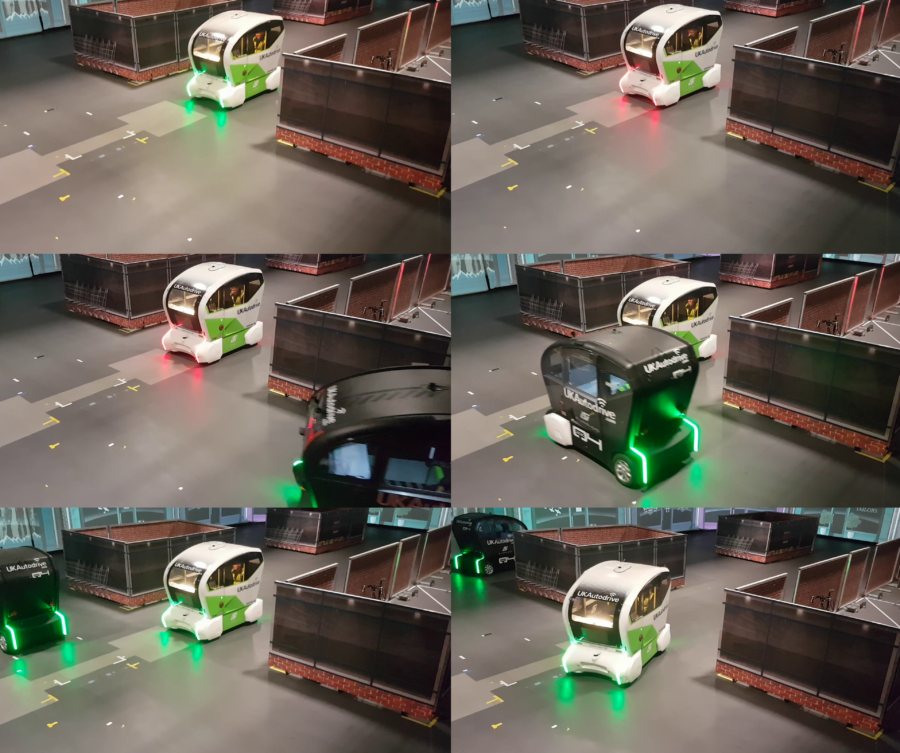Students at Warwick Manufacturing Group (WMG), an academic department at the University of Warwick, have conducted an experiment to see which autonomous vehicle (AV) driving style inspires the highest levels of confidence among passengers – driving with full machine efficiency or driving in a way that emulates average human driving. Surprisingly the results found neither to be optimal but suggested that a blend of both might work best.
The researchers took 43 volunteers into a large warehouse designed to resemble a pedestrianized area in a town center with a series of routes and junctions. Half were given four journeys around the route in an autonomous vehicle driving with full machine efficiency while the others were given four journeys around the route in AVs that tried to closely emulate average human driving patterns. They then scored the level of trust in the autonomous vehicles.
The overall result was that there was only a marginal difference in trust between the two driving methods. The efficient machine method was slightly favored but even that small advantage narrowed over the four runs. What was noticeable for both the ‘machine’ and ‘human’ driving styles is that confidence in both grew with each new round suggesting that simple familiarity will be one of the most effective ways of quickly building trust and acceptance of AVs once their use becomes more widespread.
Dr Luis Oliveira from WMG at the University of Warwick and the lead author on the paper said, “The overall trust in both driving methods grew with every run. In the machine-like driving style this was a steady upwards curve throughout the four journeys but in human-like behavior there was a particularly steep change upwards in the scores between runs two and three. The passengers in the experiment also acknowledged that future generations may be more comfortable with AVs and its features, as they learn to live with the new technology.”
The researchers also asked the participants to give some narrative about their experience and this showed that there were advantages on both modes of driving that may therefore need to be blended together in any future final package. The experiment made clear that there were two particularly clear lessons to be learned:
Smooth speed change – Drivers tend to brake at the start of any maneuver that requires deceleration while the totally automated driving programs applied speed changes more gradually and efficiently. Human passengers preferred the comfort of the smoother changes of acceleration and deceleration provided by the machine driving methods.
Sharp turns – A common complaint was a feeling that the vehicles were performing uncomfortable and worrying sharp turns. This feeling was actually expressed by both those in the machine and human style driving set ups, but it was much more noticeable in the machine-like driving style condition.
Oliveira added, “This shows that the challenge is that the speed and trajectory of autonomous vehicles should be finely controlled, but at the same time the vehicle should be assertive to provide the benefits of automated driving.”
However, it was the AVs’ behaviors at junctions that produced the most diverse and surprising reactions. The machine-driven AVs were left to make use of all of their sensors and ability to communicate with vehicles that may be out of line of sight to decide whether to enter a junction. If their sensors said it was safe and their communications with other vehicles indicated no approaching threats, they would simply enter the junction without stopping.
If, however, they detected a vehicle that they believed should have right of way – even if it was not yet visible to the human passenger, they would stop and let that vehicle pass. In contrast The AV’s emulating human driving would always stop at a junction and would even edge into the junction as if to peek at what the oncoming traffic might be.
The reactions to those two different approaches were varied and surprising. Some liked the machine driving approach of stopping at junctions even though there was no visible issue but because it was in communication with another out of sight vehicle that it perceived had right of way. But others perceived problems with the machine approach of just entering the junction if it believed it to be clear, with one passenger saying that they were concerned about vulnerable road users.
However, others were greatly surprised at the human driving method with the AV stopping at every junction. Not only did they see it as a waste of the machine’s capabilities to scan and communicate ahead to understand traffic but were also frustrated that the vehicle was not more assertive.
The conclusions drawn from the report indicate that there is a need to better educate the general public over the details of the driving systems and capabilities, for example, vehicle to vehicle communication.
For passengers in the vehicle, consideration should be given to having a display and/or audio information that shares some of the information from the vehicle so users can understand that the system is aware of hazards beyond the field of view.
There may also be some merit in presenting the full benefits of the most efficient methods of machine-based driving so that passengers can build confidence over time.



